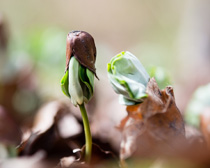
Impacted by land-use change, logging and hunting – only few natural forests remain worldwide. Human impacts not only threaten today’s forests, but also those of tomorrow. According to the first global meta-analysis conducted by scientists from Senckenberg and Goethe University Frankfurt and published today in Nature’s open access journal “Scientific Reports”, pollination and seed dispersal are the most sensitive processes in forest regeneration. This could be due to the global decline of insects, birds and mammals that are involved in these processes. To ensure global forest can regenerate in the future, it is vital that these animals are conserved.
Human disturbance negatively affects the pollination and seed dispersal of forest trees – an effect that can be observed in both tropical and temperate forests. This is the key result of a synthesis of 408 studies from 34 countries around the globe. In the long term, less pollination and seed dispersal is likely to reduce the ability of forests to natural regenerate.
The researchers investigated all processes in the plant regeneration cycle and specifically asked how much they are each affected by humans. To assess the effects of humans, they compared near-natural forests with those exposed to intensive human disturbance. The regeneration cycle of plants includes processes that are beneficial to plants, such as pollination, seed dispersal and the recruitment of seedlings, as well as detrimental processes, such as seed predation and herbivory. “We are the first to examine all important ecological processes of forest regeneration in a global meta-analysis of existing case studies,” explains Dr. Eike Lena Neuschulz, the lead author of the study from the Senckenberg Biodiversity and Climate Research Center.

In the early stages of plant regeneration, plants benefit from the interaction with animals: bees pollinate flowers and maintain gene flow among plant populations, while birds disperse seeds that can establish as seedlings at new locations. However, land use changes, hunting and overexploitation of forests threaten these animals, and thereby also their contribution toward forest regeneration. In contrast, the later processes of plant regeneration such as seed predation, recruitment and herbivory, were found to be less consistently affected by humans. Selective logging, for example, can increase the amount of light reaching the forest floor, but can also dry out the soil, which may facilitate the recruitment of some plants or inhibit that of others.
According to the research team, the species who are most affected by disturbance are large-seeded trees, whose dispersal depends on large and often endangered animals. “Our study shows that human disturbance negatively affects the early steps of the plant regeneration cycle, while the effects on the later regeneration processes vary greatly,” concludes Neuschulz, and she adds, “Our findings suggest that conservation efforts should prioritize the protection of animal pollinators and seed dispersers to maintain the regeneration potential of forest ecosystems in the future.”
Contact
Dr. Eike Lena Neuschulz
Senckenberg Biodiversity and Climate Research Centre
Tel. +49 (0)69- 7542 1872
Email: elneuschulz@senckenberg.de
Publication
Neuschulz, E.L., Mueller, T., Schleuning, M. und Böhning-Gaese, K. (2016): Pollination and seed dispersal are the most threatened processes of plant regeneration, Scientific Reports. Doi:10.1038/srep29839
www.nature.com/articles/srep29839
About Senckenberg Nature Research Society
To study and understand nature with its limitless diversity of living creatures and to preserve and manage it in a sustainable fashion as the basis of life for future generations – this has been the goal of the Senckenberg Gesellschaft für Naturforschung (Senckenberg Nature Research Society) for almost 200 years. This integrative “geobiodiversity research” and the dissemination of research and science are among Senckenberg’s main tasks. Three nature museums in Frankfurt, Görlitz and Dresden display the diversity of life and the earth’s development over millions of years. The Senckenberg Nature Research Society is a member of the Leibniz Association. The Senckenberg Nature Museum in Frankfurt am Main is supported by the City of Frankfurt am Main as well as numerous other partners.
2016 is the Leibniz year. On the occasion of the 370th birthday and the 300-year death anniversary of polymath Gottfried Wilhelm Leibniz (*7/1/1646 in Leipzig, † 11/14/1716 in Hanover), the Leibniz Association is organizing an extensive topical year. Under the title “The best of all possible worlds” – a Leibniz quote – it brings into focus the diversity and timeliness of the subject matter currently studied by the scientists at the 88 Leibniz institutions across the Federal Republic of Germany.
Source
Senckenberg Society, press release, 2016-07-20.
Supplier
Goethe-Universität Frankfurt/Main
Senckenberg Gesellschaft für Naturforschung
Share
Renewable Carbon News – Daily Newsletter
Subscribe to our daily email newsletter – the world's leading newsletter on renewable materials and chemicals












